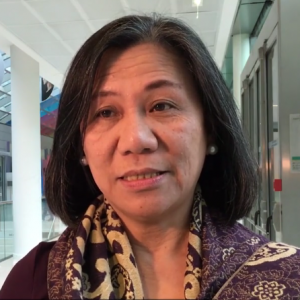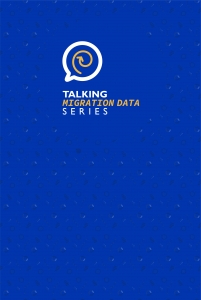En 2015, la Organización Internacional para las Migraciones (OIM) desarrolló un Marco de Gobernanza de la Migración (MiGOF) para ayudar a los Estados a definir los elementos esenciales que constituyen la base necesaria para una “política de migración bien gestionada” a nivel nacional. El MiGOF fue bien recibido por los Estados Miembros de la OIM el mismo año. Los Indicadores de Gobernanza de la Migración (IGM) han sido desarrollados para operacionalizar el MiGOF a través de cerca de noventa indicadores agrupados en seis dimensiones claves de políticas públicas.
Haga clic en la rueda para obtener más información sobre las seis dimensiones de la gobernanza de la migración incluidas en el MiGOF y los IGM.
Los IGM son una herramienta basada en el análisis de las estructuras de la gobernanza migratoria que presenta una serie de pautas sobre los instrumentos que el Estado podría usar para desarrollar su gobernanza. Los IGM evalúan únicamente el marco institucional, jurídico y de políticas públicas en materia de migración, sin entrar a evaluar su implementación en la práctica. Los IGM funcionan como un marco de referencia que permite identificar medidas que los países podrían adoptar para fortalecer sus estructuras de gobernanza de la migración. El objetivo de los IGM es contribuir a la conversación sobre la gobernanza migratoria definiendo lo que podría ser una “política migratoria bien gestionada” en el contexto de la meta 10.7 de los Objetivos de Desarrollo Sostenible (ODS).
Para obtener más información sobre el proceso de los IGM, haga clic aquí
Los indicadores de este dominio analizan los derechos de los migrantes a los servicios sociales básicos, como la salud, la educación y la seguridad social. Estos también presentan los derechos de los migrantes a la reunificación familiar, al trabajo, a la residencia y a la ciudadanía. La ratificación de las principales convenciones internacionales también se incluye dentro de este dominio.
Los indicadores de esta categoría se utilizan para definir la medida en que las personas migrantes tienen acceso a determinados servicios sociales, como la salud, la educación y la seguridad social. También remiten a las medidas adoptadas para garantizar la integración y el acceso al empleo.
Los indicadores en este dominio evalúan los marcos institucionales, legales y regulatorios de los países relacionados con las políticas migratorias. También revisan la existencia de estrategias nacionales de migración que están en línea con el desarrollo, así como la transparencia institucional y la coherencia en relación con la gestión de la migración. Este dominio investiga en qué medida los gobiernos recopilan y usan los datos de migración.
Los indicadores de esta categoría sirven para evaluar los marcos institucionales de autoridades locales o estados en lo referente a la migración. También permiten determinar la existencia de estrategias migratorias que sean acordes a los objetivos de desarrollo, así como la transparencia y coherencia institucional en relación con la gestión de la migración.
Este dominio se enfoca en los esfuerzos de los países para cooperar con otros Estados y con actores no gubernamentales (incluyendo organizaciones de la sociedad civil y el sector privado) en asuntos relacionados con la migración. La cooperación puede conducir a mejoras en la gobernanza al alinear y elevar los estándares, aumentar el diálogo y proporcionar estructuras para superar desafíos.
Los indicadores de esta categoría se centran en las medidas adoptadas por autoridades locales o estados para cooperar con los gobiernos nacionales en torno a cuestiones migratorias, así como con otros agentes no gubernamentales pertinentes, como las organizaciones de la sociedad civil y el sector privado.
Este dominio incluye indicadores sobre las políticas de los países para gestionar el bienestar socioeconómico de los migrantes, a través de aspectos como el reconocimiento de las calificaciones educativas y profesionales de los migrantes, las disposiciones que regulan la migración estudiantil y la existencia de acuerdos laborales bilaterales entre países. Los indicadores se centran igualmente en las políticas y estrategias relacionadas con el compromiso de la diáspora y las remesas de los migrantes.
Los indicadores de esta categoría permiten evaluar las iniciativas de autoridades locales o estados en lo relativo a la movilidad de estudiantes internacionales, el acceso al mercado laboral y las condiciones de trabajo decente para los trabajadores migrantes. Los aspectos relativos a la participación de las diásporas y las remesas de las personas migrantes también pertenecen a esta esfera.
Este dominio estudia el tipo y el nivel de preparación de los países cuando se enfrentan a crisis de dimensiones de movilidad, vinculadas a desastres, el medio ambiente y/o conflicto. Las preguntas se utilizan para identificar los procesos vigentes para nacionales y no nacionales durante y después de un desastre, incluso si la asistencia humanitaria está igualmente disponible para los migrantes que para los ciudadanos.
Los indicadores de esta categoría se refieren al tipo y nivel de preparación de autoridades locales o estados a la hora de encarar los aspectos relativos a la movilidad en situaciones de crisis. Permiten indagar acerca de los procesos establecidos para las personas nacionales y no nacionales tanto durante como después de desastres, incluso cuando la asistencia humanitaria está disponible en la misma medida tanto para las personas migrantes como para las nacionales del país concernido.
Este dominio analiza el enfoque de los países respecto a la gestión migratoria en términos de control fronterizo y políticas de aplicación, criterios de admisión para migrantes, preparación y resiliencia en caso de flujos migratorios significativos e inesperados, así como la lucha contra la trata de personas y el tráfico ilícito de migrantes. También evalúa los esfuerzos y los incentivos para ayudar a integrar a los ciudadanos que regresan.
Los indicadores de esta categoría sirven para evaluar el enfoque que aplican autoridades locales o estados respecto del acceso de las personas migrantes a políticas de seguridad, retorno y reintegración, así como en lo relativo a la lucha contra la trata de personas.
This country Profile describes examples of well-developed areas of the Republic of Uganda’s governance structures and areas with potential for further development, as evaluated through the six domains of the Migration Governance Indicators (MGI). These address migrants’ rights, a “whole-of-government” approach, partnerships, socioeconomic well-being of migrants, the mobility dimensions of crises, and safe and orderly migration.
Click the icons on the wheel to explore the key findings.
The Migration Governance Indicators (MGI) initiative is a policy-benchmarking programme led by the International Organization for Migration (IOM) and implemented with research and analysis from the Economist Impact. Funding is provided by IOM Member States.
Migration Governance: examples of well-developed areas
- Uganda's Health Strategic Plan (2020/21–2024/25) prioritizes ensuring that migrants, along with nationals, have equitable access to public health-care services, in line with the goal of achieving Universal Health Coverage.
- All migrants, regardless of their status, have equal access as citizens of Uganda to both primary and secondary education.
- All children born in Uganda receive birth certificates, regardless of nationality of parents, as mandated by Section 4 of the Children Act (1997).
Areas with potential for further development
- Uganda does not have bilateral agreements on the portability of social security benefits and entitlements with other countries.
- Limited civil registration services are extended to migrants without legal proof of identity in Uganda.
- There is no specific strategy for addressing hate crimes, violence, xenophobia, and discrimination against migrants.
Migration Governance: examples of well-developed areas
- The National Coordination Mechanism on Migration(2015) coordinates migration initiatives at the local, national, regional and international levels by steering migration debates and dialogue.
- The Directorate of Citizenship and Immigration Control oversees immigration policies, border management, passport issuance, and citizenship verification in Uganda, guided by the Citizenship and Immigration Control Act (2009) and the East African Community One Stop Border Posts Act of 2016.
- The Uganda Bureau of Statistics regularly collect and publish disaggregated migration data through administrative data, periodic surveys, and the national census.
Areas with potential for further development
- As of August 2023, Uganda is in the process of developing a national migration policy to guide internal, regional, and international migration, with the support of a dedicated Technical Working Group.
- Uganda lacks specific emigration legislation; the Citizenship and Immigration Control Act (2009) focuses on border control, exit measures, and deportation without explicitly addressing emigration.
- Local authorities occasionally engage in National Coordination Mechanism on Migration discussions.
Migration Governance: examples of well-developed areas
- Uganda actively engages in regional consultative processes such as the Common Market for Eastern and Southern Africa (COMESA), the East African Community (EAC) and the Intergovernmental Authority on Development (IGAD) .
- Uganda is also part of the EAC Common Market Protocol (2010), which aligns with the EAC Treaty, establishing the right to free movement of persons and labor across member states' borders.
- Members from the National Coordination Mechanism on Migration include civil society, migrant associations, academia, and labor agencies, state-owned entities, and respective ministries.
- Uganda is engaged in bilateral migration discussions with the Burundi, Rwanda, South Africa, and United Republic of Tanzania, as of August 2023.
Areas with potential for further development
- Uganda lacks a formal government framework for private sector engagement in migration policy. Ad hoc consultations occur, but limited direct engagement exists.
Migration Governance: examples of well-developed areas
- As a member of the East African Community (EAC), Uganda implements the EAC Qualifications Framework for Higher Education(2010), fostering mutual recognition of academic and professional qualifications among partner states under the EAC Common Market Protocol.
- The Government of Uganda has several bilateral labor agreements, including ones with Saudi Arabia (2015, amended in 2017), Jordan(2017) and the United Arab Emirates(2019) to enhance welfare, protect rights, and establish legal frameworks for labor migration.
- The Employment Act (2006) and Section 25 of the Constitution of Uganda (1995) promote the ethical recruitment of migrant workers, including provisions to prohibit forced labor, safeguard workers' rights, and protect children from any form of employment.
Areas with potential for further development
- Uganda does not have a national assessment for monitoring the labour market demand for immigrants or the domestic labour supply and the impact of emigration on the domestic labour market.
- The government of Uganda is not actively involved in promoting the creation of formal remittance schemes.
Migration Governance: examples of well-developed areas
- Uganda actively engages in regional frameworks like the Kampala Convention (2009) and East African Community Climate Change Policy (2015) to address climate-induced migration and internal displacement.
- The Disaster Preparedness and Management (2010) guides disaster management with specific provisions for displacement, requiring swift relief and assistance, implementation of the Kampala Convention.
- The Directorate of Relief, Disaster Preparedness and Management established National Emergency Coordination and Operations Centre in 2014, which serves as a central facility for early warning, emergency coordination, and crisis response, and disseminating crucial information for effective responses.
Areas with potential for further development
- Uganda lacks a harmonized emergency management framework that address the needs of migrants before, during and after emergencies and disasters.
- There is no policy or strategy to promote sustainable reintegration of migrants who fled the country during a crisis.
Migration Governance: examples of well-developed areas
- The Anti-Human Trafficking National Action Plan 2019–2024 (2020) includes specific measures on enforcement of laws in deterring and preventing human trafficking, victim support, and stakeholder coordination.
- Border staff undergo a mandatory six-month training at the the Directorate of Citizenship and Immigration Control, and the Immigration Training Academy in Nakasongola, Uganda.
- The Country has legislations in place to combat the exploitation of workers such including provision for protection against slavery, servitude, and forced labour, which extend to to migrant workers.
- Migrant children in Uganda are safeguarded under the National Child Policy (2020), which prioritizes community empowerment and protection for vulnerable groups, including refugees and internally displaced children.
Areas with potential for further development
- There is no formal government programme or dedicated policy that facilitates the reintegration of returning migrants.
- The establishment of formal cooperation agreements to to prevent and counter the smuggling of migrants, outside of international conventions, is an area for development.
- Uganda does not have systems or formal cooperation agreements with other countries to trace and identify missing migrants within the national territory.
2023 agosto




